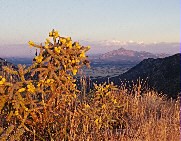
(Photo by David Bly) Many plants wilt or die in the southern Arizona summer heat, but cacti thrive on a well-protected supply of moisture stored in their succulent flesh. The cacti found at Coronado National Memorial (prickly pear, cane cholla, hedgehog, and pincushion) flower in late spring and set fruit in the dry and hot early summer so that new seeds can germinate with summer rains. Both humans and wildlife find the edible parts of these plants tasty treats, although we seem to be more challenged by their prickly exteriors! Can you imagine biting into a prickly pear pad like a javelina, without removing the spines? A spineless variety, called Indian fig or nopal, is often used to form a thick hedge in urban neighborhoods. Young pads, nopales or nopalitos, are harvested, boiled and drained, and eaten as a green vegetable. They may be sautéed and added to salsa or spaghetti sauce. Rolling the fruit in sand removes the glochids, or tiny spines (tweezers help too!) Cane cholla buds are also edible after removing the spines. They can be steamed and eaten as a gelatinous, green vegetable, similar to artichoke in taste, or dropped into stew.
Visit our keyboard shortcuts docs for details
To better understand the Palmer's agave (Agave palmeri) in the park's grassland region we trained a camera on a blooming plant. This time-lapse video shows the rapid growth and bloom of the stalk. Agaves are monocarpic, meaning they die after flowering. |
Last updated: February 24, 2015
